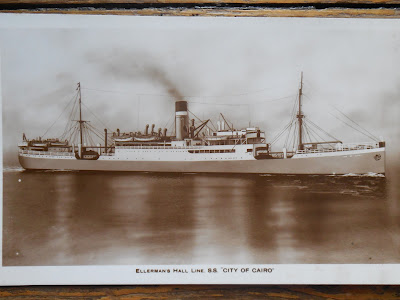 |
| Frank wrote and posted one card and kept a second card as a souvenir of his voyage from Gibraltar to England in July 1940 |
 |
| Postmark - Liverpool 12.15am 13 July 1940 |
 |
| Frank's message on the post card. |
 |
| Ellerman's Hall Line SS City of Cairo |
These letters were published 70 years to the day from when they were first written during the Phoney War (1939) and the Battle of France (1940). They were sent by my Great Uncle, mainly to his father, and provide a fascinating insight into the day to day life of a British soldier in the opening phase of World War II. I have also included information about the AASF and the Battle of France to put my Great Uncle's service in context.
Atmospheric picture of winter of a Fairey Battle on one of the AASF areodromes in the Reims area of France in 1939/40.

 |
| Frank wrote and posted one card and kept a second card as a souvenir of his voyage from Gibraltar to England in July 1940 |
 |
| Postmark - Liverpool 12.15am 13 July 1940 |
 |
| Frank's message on the post card. |
 |
| Ellerman's Hall Line SS City of Cairo |
 |
| The front of the envelope with the stamps covered and originally addressed to Frank in Gibralter. It was posted on 24 June 1940. |
 |
| The back of the envelope. Getting close - "try 157, not 159". |
 |
| A Post Office franking stamp showing the letter passed through South Kensington London SW1, on the back of the envelope. |
 |
| Anti Aircraft Division HQ stamp showing the date the letter reached finally reached Frank. |
 |
| The stamps were covered with a label but were a 1 penny and half penny stamp from the commemorative issue marking the centenary of the Penny Black. |
 |
| "Please forward LAA DIV. AA", although Frank was with an HAA Regiment (the difference being Light and Heavy). |
 |
| The date on the letter, 24 June 1940, with the final date stamp on the envelope, 17 August 1940. |
On 4 June 1940, the Regimental diary of 53rd HAA Regent recorded the completion of Operation Dynamo, the evacuation from Dunkirk. The Regiment, however, remained in France.
On 6 June 1940 (4 years away from D Day) the 53rd remained part of 12th AA Brigade and the Regiment remained "on loan" for the defenseman of Nantes.
The 157th HAA Battery had 6 guns ready for action but there was no air activity. The Battery continued with field works.
German Panzers made it to Amiens on the afternoon of 19 May 1940 cutting the AASF off from the BEF. The territorial soldiers of the 157th HAA Battery 53rd HAA (City of London) Regiment were now cut off from the channel coast and the BEF and received orders to head for Nantes.
The diary entries for 19 and 20 May 1940 read as follows:
19/05/40
08:00 Orders received that no further salvage forces will be sent out. Two guns in action ST LUCIEN FERME. One in action POUAN (EAST). One in action POUAN (WEST). Preliminary instructions received re. reorganisation of 12th (Anti Aircraft) Brigade.
20/05/40
08:00 Detailed instructions received re. reorganisation of 12th (Anti Aircraft) Brigade received and put into action. Transfer of personnel carried out and equipment handed over.
Instructions re. move of remainder of Battery to Nantes received.
The 157th Heavy Anti Aircraft Battery continues to play an active role in the battle against the Luftwaffe. After 6 months of preparing their positions e order is given to prepare to evacuate the guns sites on only the sixth day of the battle.
15/05/40
04:00 Considerable enemy air activity. Pointer rounds fired by both gun stations.
08:16 One Do. 17 brought down by Hurricanes. Many pointer rounds fired. AUBERIVE Aerodrome bombed. Considerable bombing and aerial combats in REIMS area. At least two enemy planes seen to be brought down by fighters. Emergency move orders issued and explained to Station Commanders.
09:35 Instructions received to prepare for moving guns. Sections in action all day. Gun walls removed and stores packed in readiness.
This diary entry records the first signs of problems for the BEF and AASF as the Germans commence their attack in the Sedan area.
14/05/40
0600 Considerable enemy air activity. Pointer rounds fired. PIP I placed four rounds in middle of formation of 21 Dorniers. Formation broken up. One brought down by fighter plane. Considerable activity all day. Emergency move orders received from C.O.
13/05/40
Considerable enemy air activity. Pointer rounds fired by both gun stations.
06:25 PIP I engaged enemy planes at height 4,700' [feet]. One brought down by gun fire. Bombs dropped on AUBERIVE Aerodrome. Enemy activity continued all day.